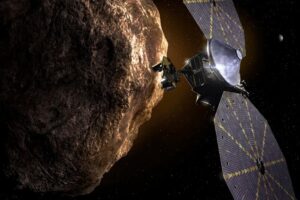On its arduous journey to Jupiter, NASA’s Lucy spacecraft encountered the first of ten asteroids on Wednesday.
In the main asteroid belt beyond Mars, the spacecraft passed the tiny Dinkinesh on Wednesday, approximately 300 million miles (480 million kilometers) away. NASA described the spacecraft’s passing at 10,000 mph (16000 kph) as “a quick hello.”
As Lucy approached Dinkinesh, it tested its instruments in a practice run for the larger and more attractive asteroid up ahead, coming within 270 miles (435 km). With a mere half-mile (1 kilometer) in diameter, Dinkinesh may be the smallest space rock on Loucy’s tour.
The Trojans, a group of undiscovered asteroids orbiting Jupiter that are thought to be time capsules from the solar system’s early days, are Lucy’s primary target. The spacecraft is scheduled to pass eight Trojans, which are thought to be between ten and one hundred times larger than Dinkinesh. In 2033, it is expected to pass by the last two asteroids.
Two years ago, NASA launched Lucy on her nearly $1 billion mission. The skeletal remains of a human ancestor discovered in Ethiopia in the 1970s, dating back 3.2 million years, inspired the name of the spacecraft. The asteroid that Lucy will next pass is called Donald Johanson, after one of the fossils Lucy finds.
The spacecraft has two solar wings, one of which is loose. It is thought to be sufficiently stable for the duration of the mission, even though flight controllers gave up trying to stabilize it.
The flyby on Wednesday completes the asteroid known by NASA as Autumn. In September, NASA returned the first asteroid debris samples. Subsequently, in October, it launched a spacecraft named Psyche to an asteroid rich in rare metals.
Lucy’s mission is not to stop at asteroids or gather samples like those missions did.
The spacecraft’s return of all its images and data from the flyby will take at least a week.


